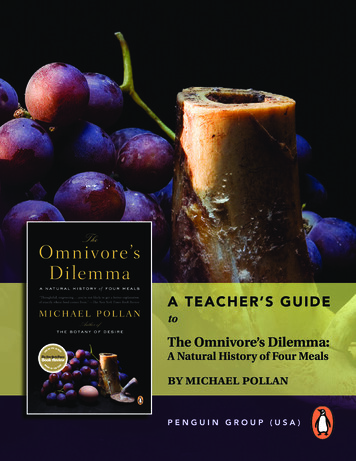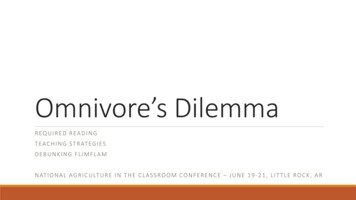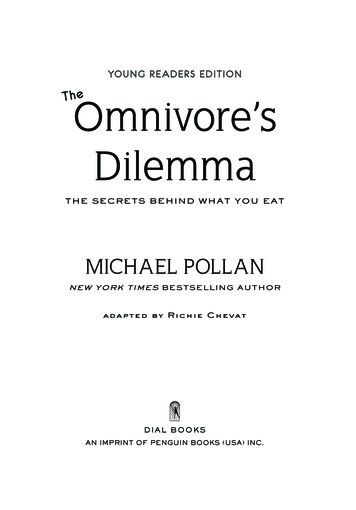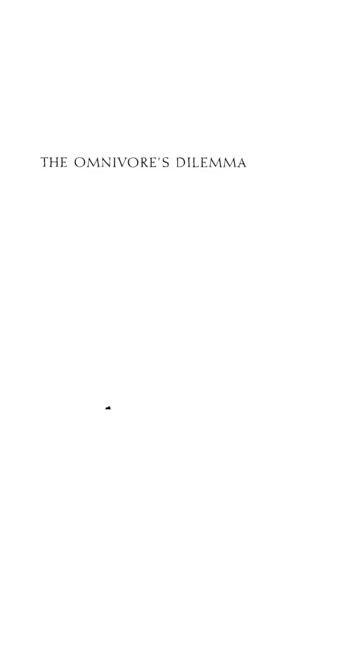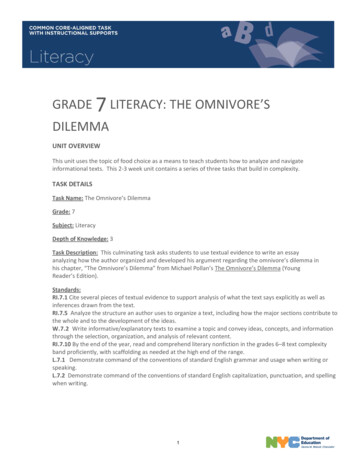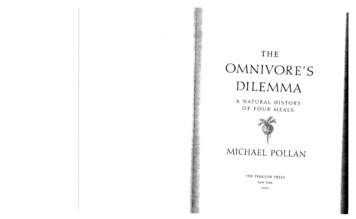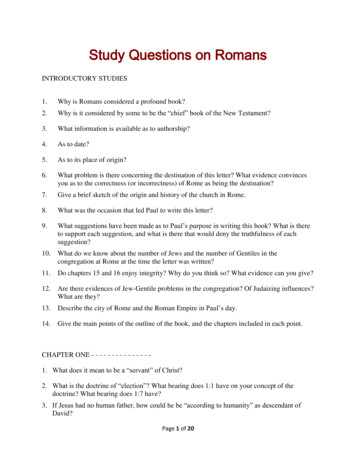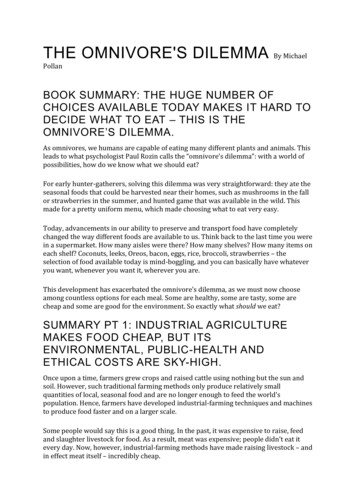
Transcription
THE OMNIVORE'S DILEMMABy MichaelPollanBOOK SUMMARY: THE HUGE NUMBER OFCHOICES AVAILABLE TODAY MAKES IT HARD TODECIDE WHAT TO EAT – THIS IS THEOMNIVORE’S DILEMMA.As omnivores, we humans are capable of eating many different plants and animals. Thisleads to what psychologist Paul Rozin calls the “omnivore’s dilemma”: with a world ofpossibilities, how do we know what we should eat?For early hunter-gatherers, solving this dilemma was very straightforward: they ate theseasonal foods that could be harvested near their homes, such as mushrooms in the fallor strawberries in the summer, and hunted game that was available in the wild. Thismade for a pretty uniform menu, which made choosing what to eat very easy.Today, advancements in our ability to preserve and transport food have completelychanged the way different foods are available to us. Think back to the last time you werein a supermarket. How many aisles were there? How many shelves? How many items oneach shelf? Coconuts, leeks, Oreos, bacon, eggs, rice, broccoli, strawberries – theselection of food available today is mind-boggling, and you can basically have whateveryou want, whenever you want it, wherever you are.This development has exacerbated the omnivore’s dilemma, as we must now chooseamong countless options for each meal. Some are healthy, some are tasty, some arecheap and some are good for the environment. So exactly what should we eat?SUMMARY PT 1: INDUSTRIAL AGRICULTUREMAKES FOOD CHEAP, BUT ITSENVIRONMENTAL, PUBLIC-HEALTH ANDETHICAL COSTS ARE SKY-HIGH.Once upon a time, farmers grew crops and raised cattle using nothing but the sun andsoil. However, such traditional farming methods only produce relatively smallquantities of local, seasonal food and are no longer enough to feed the world’spopulation. Hence, farmers have developed industrial-farming techniques and machinesto produce food faster and on a larger scale.Some people would say this is a good thing. In the past, it was expensive to raise, feedand slaughter livestock for food. As a result, meat was expensive; people didn’t eat itevery day. Now, however, industrial-farming methods have made raising livestock – andin effect meat itself – incredibly cheap.
Out-of-season produce has also become widely available. You live in Seattle but wantfresh asparagus in January? No problem; it’s shipped from Argentina. Add to this thefact that the growth seasons of many plants have been extended to unnatural lengthsthrough industrial-farming techniques, and you can pretty much buy any fruit orvegetable whatever the season.Unfortunately, cheap meat and year-round asparagus come at a cost: in the name ofefficiency and mass production, large-scale industrial agriculture pollutes the air andwater, pumps chemicals and pesticides into our food, treats animals unethically andspreads diseases.SUMMARY PT 2: CORN IS ONE OF THE MOSTIMPORTANT CROPS IN THE UNITED STATES,AND IT’S HEAVILY SUBSIDIZED BY THEGOVERNMENT.Corn is very adaptable and genetically robust. It produces large harvests quicker thanother crops, so when Europeans discovered corn when they colonized the Americas inthe sixteenth century, it quickly became a staple crop. As technology advanced, farmersbegan breeding corn hybrids to optimize output even further. Advancements includedthicker stalks and stronger root systems that could withstand harsh mechanicalharvesting and also stand closer together to fit more plants per acre.As these varieties were adopted by farmers, corn production quickly increased. In 1920,farmers produced 20 bushels of corn per acre; they now produce 180.In 2005, it cost a farmer about 2.50 to produce a bushel of corn. But due to theabundance of corn, buyers were only willing to pay 1.45 per bushel. Of course, iffarmers were to lose a dollar on every bushel of corn they produced, they would go outof business, which is why the US government subsidizes the farmers by making up thedifference.With such subsidies, the system of supply and demand becomes irrelevant. The farmerssimply flood the market with corn and still make a (wholly artificial) profit on everybushel. Hence, the price of corn keeps dropping, but the US keeps producing more corn.SUMMARY PT 3: TO SELL THE EXCESS CORNFARMERS PRODUCE, COMPANIES ADDPROCESSED CORN-BASED INGREDIENTS TOFOOD.These days, corn is less of a food and more of a commodity. In fact, one in four items inthe average American supermarket contains corn in one form or another. Chicken
nuggets, for example, are usually made of cornstarch, corn oil and chicken that was fedcorn.So why is corn everywhere?Food industry executives have long faced the fixed stomach problem; every person canonly eat about 1,500 pounds of food each year. To grow, food industry companies likeGeneral Mills and McDonald’s have to convince people to (a) spend more money onthose 1,500 pounds of food, and/or (b) eat more than 1,500 pounds of food per year.In this regard, America’s huge corn surplus is particularly problematic, since there ismore corn than the population could possibly eat. This is why much of our corn goes toso-called wet mills, where it is repurposed to create a wide array of artificial-soundingingredients, such as “high fructose corn syrup” or “hydrogenated fat” found on nutritionfacts labels. These synthetic ingredients are then used in a variety of foods like soda, TVdinners, breakfast cereals and so forth.These new uses for excess corn are very profitable for the food industry. Heavyprocessing greatly extends the shelf life of products, allowing food corporations to takea larger slice of the profits and leaving farmers with less. When you buy chickennuggets, for example, you pay very little for the actual chicken and a lot for the servicesrequired to turn the corn into synthetic corn-based ingredients and then those intosomething that resembles food.SUMMARY PT 4: MEAT PRICES HAVE BEENBROUGHT DOWN BY THE USE OF MONOLITHICMASS-FEEDING OPERATIONS CALLED CAFOS.Besides going into processed foods, much of the corn surplus is also used to feed farmanimals that we later eat. From the food industry’s perspective, animals are likemachines that turn excess corn into sellable meat, though machines are usually treatedbetter.Enter concentrated animal feeding operations, or CAFOs for short.CAFOs are facilities for raising animals unlike any farm you have ever imagined. Theymaximize efficiency – and profit – by cramming as many animals as possible into cagesor pens while automating and mechanizing as much farm work as possible, such asfeeding. This efficiency ethos, as well as the cheap feed due to the corn surplus, hasbrought meat prices down to previously unheard of levels.Before the advent of CAFOs, the care, time and resources needed to raise animals onsmall, local farms meant meat was expensive: a rare treat. But today, a baconcheeseburger, for example, is so cheap you can eat one every day if you want to –something many people do.
SUMMARY PT 5: TO KEEP MEAT CHEAP, CAFOSTREAT ANIMALS UNETHICALLY AND CAUSEHUGE ENVIRONMENTAL AND HEALTH RISKS.At first glance, CAFOs might even sound like a good thing: Who would object to cheapand delicious bacon cheeseburgers? Unfortunately, they come at the price of animalrights, sustainability and public health.CAFOs operate by optimizing output to maximize profit. Animals are forced intocrowded spaces without access to pasture or space to move around, leading to sufferingand the spread of diseases.Corn is so cheap that CAFOs use it as animal feed whether the animals have evolved toeat it or not. Even a carnivorous fish like salmon is being reengineered to tolerate corn.Because cattle wouldn’t normally eat corn either, at CAFOs they suffer from all mannerof illnesses – think bloat so intense that it can press on a cow’s lungs and suffocate it,and heartburn so severe it causes ulcers, liver disease and a weakened immune system.The only way to keep animals alive until slaughter in such conditions is by pumpingthem full of antibiotics. However, overusing antibiotics to keep sick animals alive canlead to the development of antibiotic-resistant “superbugs,” which can wreak havoc inhuman populations too.If you thought that was the worst of CAFO offenses, think again. They also contaminatedownstream waters with the hormones and heavy metals they use. The fertilizer theiranimals produce is often used on industrial farms, and could easily spread a new, lethalstrain of E. coli, born in the dangerously unhealthy conditions at CAFOs.Ethics, the environment and public health are all secondary concerns to CAFOs. Whatthey really care about is maximizing efficiency and profit.SUMMARY PT 6: ORGANIC FOOD OFFERS SOMEBENEFITS OVER CONVENTIONALLY PRODUCEDFOOD Originally, the movement started as a grassroots initiative to solve a lot of the problemscaused by industrial agriculture: pollution, pesticides, and the fossil fuel demands ofshipping fruits and vegetables around the country. Organic was more expensive thanconventional produce, but the process was much better for the environment and thefood far healthier for people.At the beginning of the movement, many farmers started out by selling produce fromstands on the side of the road rather than shipping their products across the country.And rather than using pesticides and chemical fertilizer, they used natural, often localcompost or manure from nearby farms.
Many studies have compared organic produce with that grown industrially. The resultsindicate that produce grown without pesticides and chemical inputs is both bettertasting and healthier.When tomatoes are allowed to grow at their natural pace – without chemicals to speedup growth – they develop thicker cell walls, which gives them more concentratedflavors and hence a far better taste.What’s more, other studies have found that organic fruits and vegetables contain morevitamins and cancer-fighting polyphenols than conventional ones.SUMMARY PT 7: BUT THE ORGANIC FOODSYSTEM TODAY IS FAR FROM PERFECT.Picture a happy cow grazing on luscious green grass amid rolling hills. This is probablywhere you imagine your organic milk came from, partially because the image oftenadorns organic milk cartons. This idyll is compelling – so compelling that customers arewilling to pay a higher price for it and food companies know this.But “organic” doesn’t necessarily mean what you think it means.As the organic movement gained popularity, small, idyllic farms like the one in yourimagination couldn’t keep up with demand. They expanded – and that meant sacrificingsome of the movement’s original ideals. In fact, many problems of conventionalagriculture are present on large-scale organic farms, too.As the organic business grew, the US Department of Agriculture developed laxstandards that allowed food companies to cut corners and still get labels like “organic”or “free-range” for which environmentally conscious consumers are willing to pay more.Although smaller producers fought for stricter regulations, big corporations won out.Under these vague guidelines, you can, for example, cram 20,000 chickens into a shedwith two weeks’ access to a small yard and call them “free range.” Similarly, oddities like“organic TV dinners” and “organic high-fructose corn syrup” have emerged.Although smaller organic farms do still exist, most organic food in supermarkets comesfrom big ones that cut corners. This is because supermarkets want to stock a full rangeof fruits and vegetables year-round, regardless of local and seasonal availability.Unfortunately, small companies usually only produce what grows locally and seasonally,whereas large ones can use industrial techniques to overcome these limitations.SUMMARY PT 8: MANAGEMENT-INTENSIVEGRAZING IS A FAR MORE NATURAL AND
SUSTAINABLE ALTERNATIVE TOOVERPRODUCING CORN.As we’ve already learned, corn plays a major role in creating the myriad problems of theconventional food system, not least of which is the havoc corn wreaks on cows’digestive systems. But growing corn also neglects many natural coevolutionaryrelationships that could be taken advantage of.One of the best ways to optimize production sustainably is to grow grass instead of cornand to use management-intensive grazing – a farming technique that involves movinganimals to different pastures every day to promote optimum grass growth using theplant’s natural growth cycle.This method takes advantage of the coevolutionary relationship between cows andgrass that is wholly ignored in industrial agriculture. Cows don’t overgraze theirfavorite kinds of grass, which allows a diversity of species to thrive in the pasture, andat the same time they get to enjoy their natural diet rather than harmful corn thatmakes them sick and bloated. And healthier cows produce healthier meat.Management-intensive grazing is also better for the environment. The naturalbiodiversity of grass that flourishes – unheard of in the sea of corn that is the AmericanMidwest – maximizes absorption of solar energy and carbon. The grass effectively takesthousands of pounds of carbon out of the atmosphere and stores it underground.SUMMARY PT 9: SMALL, LOCAL FARMSPROVIDE AN ECONOMICALLY,ENVIRONMENTALLY AND ETHICALLYSUSTAINABLE ALTERNATIVE.Our current system for producing food values efficiency and profits over ethicalconcerns, environmental sustainability and consumers’ health.So what can we do? We can buy from small, local farms instead of large, industrial ones.First of all, buying locally helps reduce the amount of fossil fuels needed to transportfood from the producer to the consumer, a distance which today might span countriesor even continents.Also, from an economic standpoint, buying locally helps put profits in the hands of smallbusiness owners and farmers rather than huge corporations.What’s more, small, local farms don’t rely on pesticides or unnatural farming techniquesto produce large amounts of food. Instead, they grow food seasonally, promoting thenatural ecosystem rather than interfering with it. This makes them the obviousenvironmental choice, too.
Finally, local farms are almost always the more ethical choice. Being able to drive downthe road to see a butcher or farmer at work creates accountability, which makes themless likely to resort to unethical practices, such as treating animals poorly just toincrease profits.IN REVIEW: THE OMNIVORE’S DILEMMA BOOKSUMMARYThe key message in this book:Much of the food we eat today is produced industrially, which often meansunethical practices, environmental damage and that the food contains someprocessed derivative of corn – a crop produced far in excess of our needs. Whileorganic food does provide some advantages over this system, it is not without itsproblems. The best solution is to buy from small, local farms.https://conscioused.org
THE OMNIVORE'S DILEMMA By Michael Pollan BOOK SUMMARY: THE HUGE NUMBER OF CHOICES AVAILABLE TODAY MAKES IT HARD TO DECIDE WHAT TO EAT – THIS IS THE OMNIVORE’S DILEMMA. As omnivores, we humans are capable of eating many different plants and animals. This leads to what psychologist Paul Rozi
